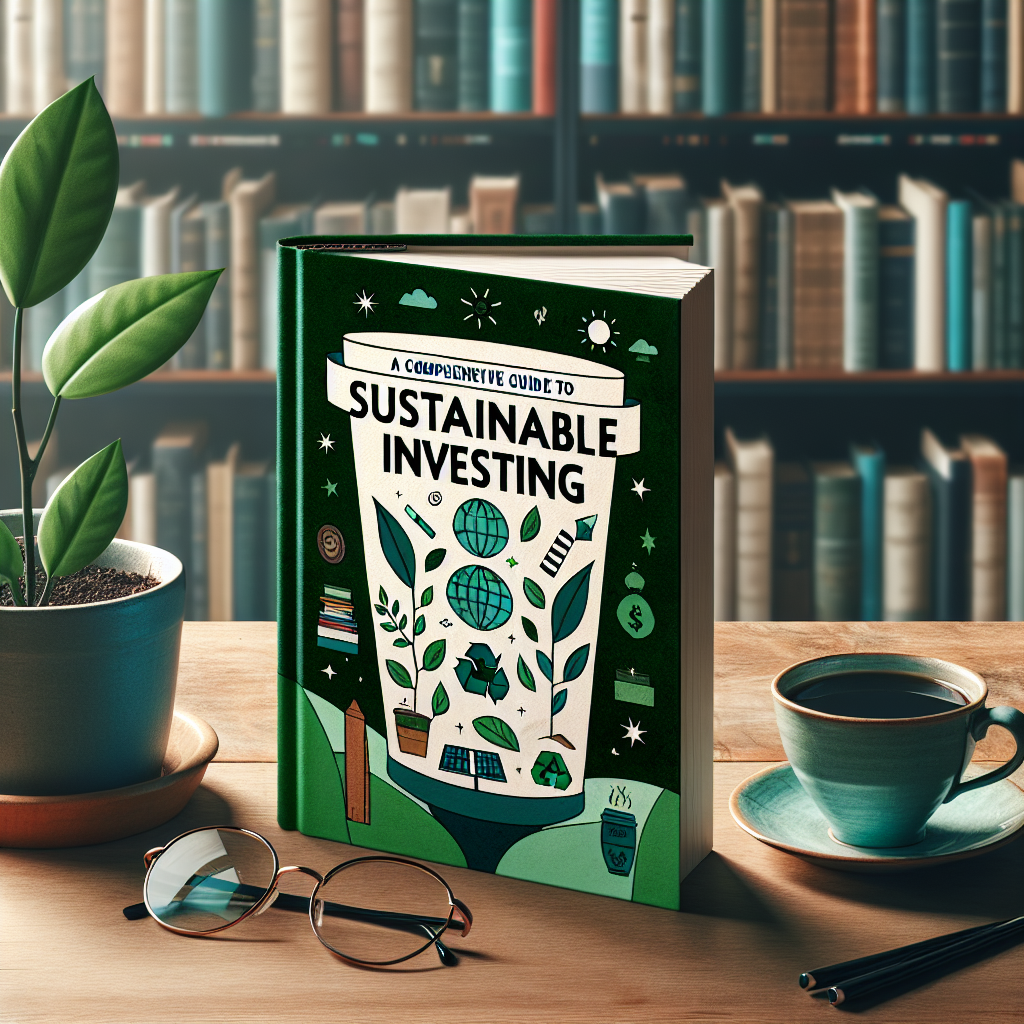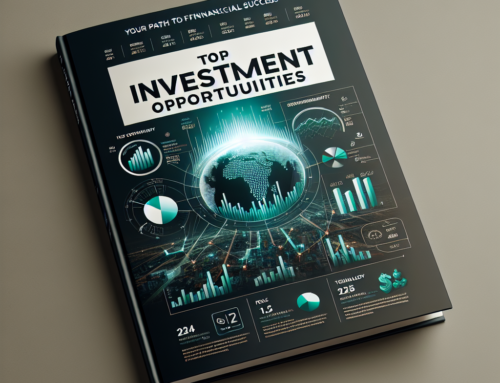
Understanding the Basics of Sustainable Investing
Sustainable investing, also known as socially responsible investing, has gained significant traction in recent years as more and more individuals are becoming conscious of the impact their investments have on the environment and society. This type of investing involves considering not only financial returns but also the environmental, social, and governance (ESG) factors of a company before making investment decisions. In this article, we will provide a comprehensive guide to understanding the basics of sustainable investing.
First and foremost, it is important to understand the concept of sustainability. Sustainability refers to meeting the needs of the present without compromising the ability of future generations to meet their own needs. In the context of investing, this means investing in companies that are not only profitable but also have a positive impact on the environment and society.
One of the key principles of sustainable investing is ESG integration. This involves considering environmental, social, and governance factors in the investment decision-making process. Environmental factors include a company’s impact on the environment, such as its carbon footprint and use of natural resources. Social factors refer to a company’s impact on society, including its treatment of employees, human rights practices, and community involvement. Governance factors involve the company’s leadership, board structure, and transparency.
Another important aspect of sustainable investing is impact investing. This involves investing in companies or projects that have a specific social or environmental goal, in addition to financial returns. Impact investing allows investors to align their values with their investments and make a positive impact on the world.
One common misconception about sustainable investing is that it sacrifices financial returns for the sake of social and environmental impact. However, numerous studies have shown that sustainable investing can actually lead to better financial performance in the long run. This is because companies that prioritize ESG factors tend to have better risk management, stronger relationships with stakeholders, and are better positioned to capitalize on emerging opportunities.
Now that we have covered the basics of sustainable investing, let’s delve into the different approaches to implementing this investment strategy. The first approach is negative screening, which involves excluding certain industries or companies from the investment portfolio based on their ESG practices. This could include avoiding investments in companies involved in fossil fuels, tobacco, or weapons.
The second approach is positive screening, which involves actively seeking out companies that have strong ESG practices and including them in the investment portfolio. This approach allows investors to support companies that align with their values and have a positive impact on the world.
Another approach is thematic investing, which involves investing in specific themes or issues, such as renewable energy, gender equality, or sustainable agriculture. This allows investors to target specific areas of impact and support companies that are working towards addressing these issues.
Finally, there is also the option of shareholder engagement, where investors use their influence as shareholders to encourage companies to improve their ESG practices. This could involve voting on shareholder resolutions, engaging in dialogue with company management, and collaborating with other investors to push for change.
In conclusion, sustainable investing is a growing trend that allows investors to align their values with their investments and make a positive impact on the world. By considering ESG factors and using different approaches to implementing this investment strategy, investors can not only achieve financial returns but also contribute to a more sustainable and equitable future. So, whether you are a seasoned investor or just starting, consider incorporating sustainable investing into your portfolio and be a part of the movement towards a better world.
The Importance of Environmental, Social, and Governance (ESG) Factors in Investing
Investing has always been a popular way to grow one’s wealth and secure a stable financial future. However, in recent years, there has been a shift towards a more conscious and responsible approach to investing. This is where sustainable investing comes into play. Sustainable investing, also known as socially responsible investing, is the practice of investing in companies that prioritize environmental, social, and governance (ESG) factors. In this article, we will delve into the importance of ESG factors in investing and how they can benefit both investors and the world.
First and foremost, let’s understand what ESG factors are. Environmental factors refer to a company’s impact on the environment, such as its carbon footprint, use of renewable energy, and waste management practices. Social factors encompass a company’s treatment of its employees, customers, and the community. This includes diversity and inclusion, labor practices, and community involvement. Governance factors, on the other hand, focus on a company’s leadership, transparency, and ethical practices.
Now, you may be wondering why these factors are important in investing. The answer is simple – they can have a significant impact on a company’s financial performance. Companies that prioritize ESG factors tend to have better long-term financial performance and are less likely to face legal or reputational risks. This is because they are more resilient to environmental and social challenges, and have strong governance structures in place.
Moreover, investing in companies that prioritize ESG factors can also align with your personal values and beliefs. For instance, if you are passionate about environmental conservation, you can choose to invest in companies that have a positive impact on the environment. This way, you can use your money to support causes that are important to you while also earning a return on your investment.
In addition to personal values, sustainable investing can also have a positive impact on the world. By investing in companies that prioritize ESG factors, you are essentially supporting and promoting sustainable practices. This can lead to a more sustainable and equitable future for all. Furthermore, sustainable investing can also drive positive change by influencing companies to adopt more responsible practices. As more investors demand ESG considerations, companies will be incentivized to prioritize these factors to attract investment.
Now that we understand the importance of ESG factors in investing, let’s look at how you can incorporate them into your investment strategy. The first step is to do your research. Look for companies that have a strong track record of ESG performance and align with your values. You can also seek guidance from financial advisors or use online tools that specialize in sustainable investing.
Another way to incorporate ESG factors into your investment strategy is through ESG-themed funds. These are mutual funds or exchange-traded funds (ETFs) that specifically invest in companies that prioritize ESG factors. This can be a convenient option for those who do not have the time or expertise to research individual companies.
It is also essential to keep in mind that sustainable investing does not mean sacrificing returns. In fact, studies have shown that companies with strong ESG performance tend to outperform their peers in the long run. This is because they are better equipped to handle risks and adapt to changing market conditions.
In conclusion, the incorporation of ESG factors in investing is crucial for both financial success and creating a positive impact on the world. By considering these factors in your investment decisions, you can align your portfolio with your values and contribute to a more sustainable future. So, whether you are a seasoned investor or just starting, it’s never too late to start incorporating ESG factors into your investment strategy.
How to Identify and Evaluate Sustainable Investment Opportunities
Sustainable investing, also known as socially responsible investing, has gained significant traction in recent years as more and more individuals and institutions are looking to align their investments with their values. This type of investing involves considering not only financial returns but also the environmental, social, and governance (ESG) impact of a company or organization. In this comprehensive guide, we will explore how to identify and evaluate sustainable investment opportunities.
The first step in identifying sustainable investment opportunities is to understand what makes a company or organization sustainable. There are various frameworks and guidelines that can help with this, such as the United Nations Sustainable Development Goals (SDGs) and the Global Reporting Initiative (GRI). These frameworks provide a set of criteria that companies can use to measure and report on their sustainability performance. By familiarizing yourself with these frameworks, you can better assess the sustainability of potential investments.
Another important aspect to consider when identifying sustainable investment opportunities is the company’s ESG practices. This includes factors such as their carbon footprint, diversity and inclusion policies, and labor practices. Companies that prioritize sustainability and have strong ESG practices are more likely to have a positive impact on the environment and society, making them attractive investment opportunities for those looking to make a difference with their investments.
In addition to understanding the sustainability and ESG practices of a company, it is also crucial to evaluate their financial performance. After all, sustainable investing is still investing, and financial returns are an important consideration. Fortunately, there is a growing body of evidence that suggests that sustainable investing can lead to strong financial returns. A study by Morgan Stanley found that sustainable funds had similar or better returns than traditional funds over the past decade. This is because companies with strong sustainability practices are often better positioned to weather risks and capitalize on opportunities, making them more resilient in the long run.
Once you have identified potential sustainable investment opportunities, the next step is to evaluate them thoroughly. This involves conducting a thorough analysis of the company’s financials, sustainability practices, and ESG performance. It is also important to consider the industry and market trends, as well as any potential risks and challenges that the company may face. This evaluation process can be time-consuming, but it is crucial to ensure that your investments align with your values and have the potential for strong financial returns.
One helpful tool in evaluating sustainable investments is impact investing. This approach involves investing in companies or organizations that have a specific social or environmental mission, in addition to financial returns. Impact investing allows you to directly support causes and issues that are important to you while also potentially earning a return on your investment. However, it is important to thoroughly research and understand the impact of the investment to ensure that it aligns with your values and has the potential for financial success.
In addition to conducting your own research, it can also be helpful to seek guidance from a financial advisor or sustainable investment expert. They can provide valuable insights and help you navigate the complex world of sustainable investing. They can also help you identify potential risks and opportunities that you may have overlooked.
In conclusion, sustainable investing offers a way to align your investments with your values and make a positive impact on the world. By understanding what makes a company sustainable, evaluating their financial and ESG performance, and seeking guidance when needed, you can identify and evaluate sustainable investment opportunities that have the potential for both financial returns and positive change. Remember to always do your due diligence and stay informed about the latest trends and developments in sustainable investing to make the most informed decisions for your portfolio.
The Role of Impact Investing in Creating Positive Change
Sustainable investing, also known as socially responsible investing, has gained significant traction in recent years as individuals and institutions alike have become more conscious of the impact their investments have on the world. This type of investing involves considering not only financial returns, but also the environmental, social, and governance (ESG) factors of a company or organization. In this comprehensive guide, we will explore the role of impact investing in creating positive change and how you can incorporate it into your investment strategy.
Impact investing is a subset of sustainable investing that focuses specifically on generating positive social and environmental impact alongside financial returns. This type of investing is driven by the belief that businesses have a responsibility to contribute to the betterment of society and the planet. Impact investors seek out companies and organizations that align with their values and actively work towards creating positive change in the world.
One of the key ways impact investing creates positive change is by directing capital towards companies and organizations that are addressing pressing social and environmental issues. This can include investing in renewable energy companies, sustainable agriculture, or organizations that promote social justice and equality. By investing in these types of companies, impact investors are not only supporting their financial growth, but also contributing to the advancement of important causes.
Another way impact investing creates positive change is by holding companies accountable for their actions. Impact investors often use their influence as shareholders to push for more sustainable and ethical practices within companies. This can include advocating for better labor practices, reducing carbon emissions, or promoting diversity and inclusion within the company. By using their financial power, impact investors can drive positive change within the corporate world.
In addition to creating positive change, impact investing also offers financial benefits. Studies have shown that companies with strong ESG practices tend to outperform their peers in the long run. This is because these companies are better equipped to manage risks and adapt to changing market conditions. By incorporating ESG factors into their investment decisions, impact investors can potentially achieve both financial and social returns.
One of the challenges of impact investing is measuring the impact of investments. Unlike traditional investing, where financial returns can be easily quantified, measuring the social and environmental impact of investments can be more complex. However, there are various tools and frameworks available to help investors assess the impact of their investments. These include the United Nations Sustainable Development Goals (SDGs), which provide a set of 17 global goals to achieve a more sustainable future, and the Global Impact Investing Network’s (GIIN) Impact Reporting and Investment Standards (IRIS), which offers a standardized way to measure and report on impact.
It’s important to note that impact investing is not a one-size-fits-all approach. Each investor may have different values and priorities, and therefore, their impact investing strategy may look different. Some may focus on environmental issues, while others may prioritize social justice. The key is to find investments that align with your values and have a positive impact in areas that are important to you.
In conclusion, impact investing plays a crucial role in creating positive change in the world. By directing capital towards companies and organizations that are addressing social and environmental issues, holding companies accountable for their actions, and potentially achieving financial returns, impact investors are making a difference in the world while also growing their wealth. As more individuals and institutions embrace impact investing, we can hope to see a more sustainable and equitable future for all.
Navigating the Challenges and Risks of Sustainable Investing
Sustainable investing, also known as socially responsible investing, has gained significant traction in recent years as more and more individuals and institutions seek to align their investments with their values. This approach to investing takes into consideration not only financial returns, but also the impact of investments on the environment, society, and corporate governance. While sustainable investing offers the potential for both financial and social returns, it also comes with its own set of challenges and risks. In this comprehensive guide, we will explore these challenges and risks and provide tips on how to navigate them.
One of the main challenges of sustainable investing is defining what exactly constitutes a sustainable investment. With the growing popularity of this approach, there has been an influx of investment products marketed as “sustainable” or “green”. However, not all of these products may align with your personal values or have a significant impact on the issues you care about. This is where thorough research and due diligence come into play. It is important to look beyond the marketing and dig deeper into the companies and industries that the investment product supports. Look for certifications or third-party ratings that can provide a more objective assessment of a company’s sustainability practices.
Another challenge is the lack of standardization and transparency in sustainable investing. Unlike traditional investing, where financial metrics are well-defined and easily comparable, sustainable investing is still in its early stages and lacks a universal set of standards. This can make it difficult for investors to evaluate the sustainability performance of companies and compare different investment products. To address this challenge, it is important to work with a financial advisor or investment firm that specializes in sustainable investing and has a clear methodology for evaluating and selecting investments.
In addition to challenges, sustainable investing also comes with its own set of risks. One of the main risks is the potential for lower financial returns. Some investors may be hesitant to allocate a portion of their portfolio to sustainable investments because they fear it may negatively impact their overall returns. However, studies have shown that sustainable investments can perform just as well, if not better, than traditional investments. In fact, companies with strong sustainability practices may be better positioned to weather economic downturns and outperform their peers in the long run. It is important to keep in mind that sustainable investing is a long-term strategy and may require patience and a willingness to forgo short-term gains for the sake of long-term impact.
Another risk to consider is the potential for “greenwashing”. This is when companies or investment products falsely claim to be sustainable or environmentally friendly in order to attract investors. To avoid falling victim to greenwashing, it is important to do your own research and look for third-party certifications or ratings. It is also helpful to diversify your sustainable investments across different industries and sectors to mitigate the risk of investing in a company that may not be as sustainable as it claims.
In conclusion, sustainable investing offers the potential for both financial and social returns, but it also comes with its own set of challenges and risks. By thoroughly researching and evaluating investment products, working with a specialized financial advisor, and diversifying your investments, you can navigate these challenges and mitigate the risks associated with sustainable investing. Remember, sustainable investing is a long-term strategy and may require patience and a willingness to forgo short-term gains for the sake of creating a more sustainable future.
We have lots of exciting coming events in Entrepreneurship, Investing and Personal Development. You can find them all here:
www.swedishwealthinstitute.se/events




